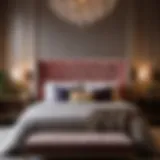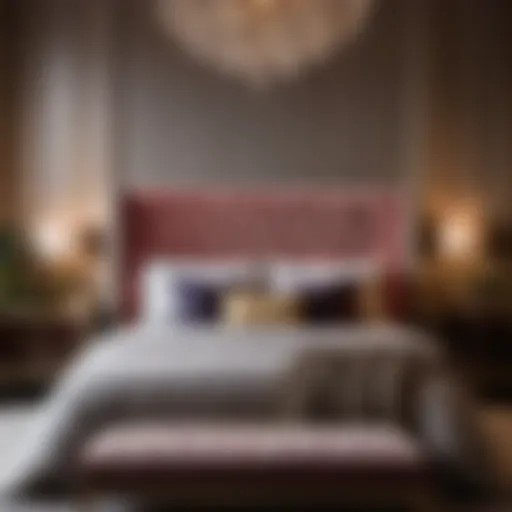Enhancing Bathroom Design with Wainscoting
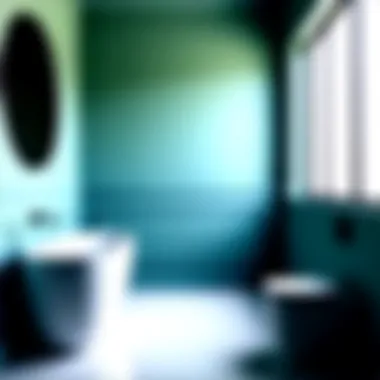
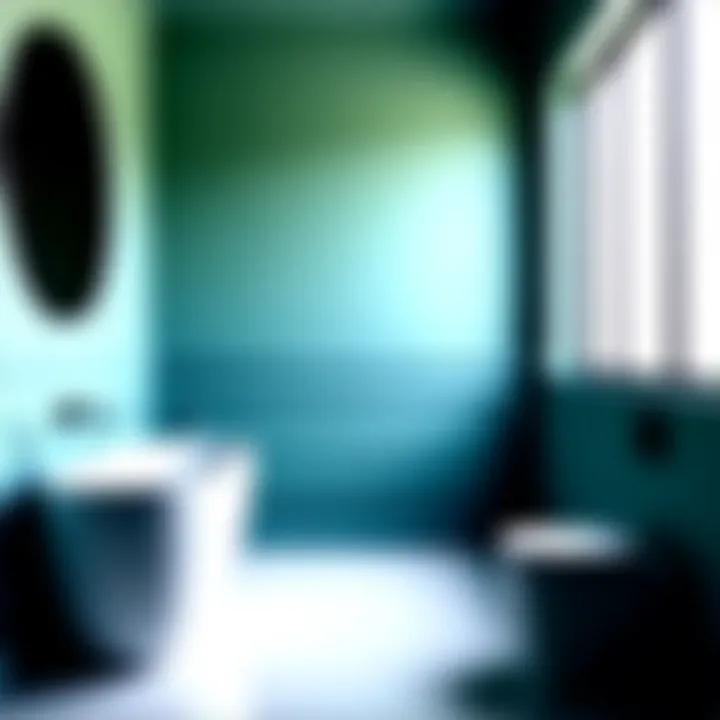
Intro
Wainscoting has been a popular design element in various settings for centuries. It adds elegance and depth to a room. In bathrooms, it not only serves an aesthetic function but also offers protection to walls from moisture and damage. This article covers the aspects of using wainscoting in bathrooms, especially focusing on the planning, materials, installation, and maintenance involved.
Materials:
Before embarking on your wainscoting project, gathering the right materials is essential. Below is a detailed list of materials needed for a standard bathroom wainscoting application:
- Wainscoting Panels: 8 ft x 4 ft sheets, quantity depends on the bathroom size.
- Molding: Baseboard and cap molding, typically 2 in. x 4 in., length calculated per room perimeter.
- Adhesive: Construction adhesive, one tube for every two panels.
- Paint or Stain: 1 gallon serves for multiple coats, depending on desired finish.
- Primer: 1 quart for initial coating on raw wood or unpainted surfaces.
DIY Steps:
Detailed Instructions:
- Measure the Walls: Start by measuring the height and width of the walls you want to cover. Determine the desired height for the wainscoting; generally, this can range from 32 to 48 inches.
- Plan Your Layout: Decide on the design whether it will be traditional raised panels or beadboard style. Sketch a layout to visualize.
- Cutting the Panels: Carefully cut the wainscoting panels to size based on your measurements. Properly use a miter saw for clean cuts.
- Prepare the Walls: Clean the walls to ensure adhesion. Repair any damage or holes. Optionally, add a layer of primer.
- Apply Adhesive: Use construction adhesive on the back of each panel. Press panels against the wall, ensuring they are aligned.
- Secure Panels: Use finishing nails to secure the panels into the wall studs. This added step provides extra stability.
- Attach Molding: Cut and install baseboard and cap molding around the edges using similar methods as the panels.
- Finish Coats: Apply primer and then paint or stain the panels and moldings. Apply at least two coats for durability.
- Cleanup: Remove any excess adhesive and clean tools used. Step back to appreciate your work.
Technical Aspects:
It is also crucial to have the right tools handy for this project:
- Miter Saw
- Measuring Tape
- Level
- Nail Gun or Hammer
- Paint Brush/Roller
The expected timeline for the installation might range from a few hours to a few days, depending on your skill level and wall size.
Troubleshooting Tips:
Here are some tips for common mistakes:
- Uneven Panels: Use a level to ensure all panels are aligned correctly.
- Adhesive Leakage: Clean edges promptly before adhesive cures.
- Paint Streaks: Use a high-quality brush and apply multiple thin coats for a smooth finish.
"The transformation from plain walls to elegant wainscoting can uplift the bathroom ambiance significantly."
Wainscoting in bathrooms is not just a decorative choice; it enhances both style and function. Through careful planning and execution, it can result in an awe-inspiring transformation.
Understanding Wainscoting
Wainscoting has become an intriguing seduction in interior design, especially in bathrooms. Its application offers a blend of convenience and visual dazzle. This section elucidates the significance of wainscoting and outlines what homeowners must contemplate before adopting this stylish element.
Definition of Wainscoting
Wainscoting refers to the decorative wall paneling that covers the lower portion of walls, typically extending between one-third to two-thirds of the wall height. Traditional wainscoting structures are built from wood, although variations now include composite materials. The primary purpose is to protect walls from damage while providing an aesthetic enhancement, especially in humid settings like bathrooms.
Historical Context
The origins of wainscoting can be traced back to the 16th century, primarily as a practical approach to protect walls from moisture and wear. This feature caught the imagination of architects and designers throughout various historical eras, evolving from simple wooden panels to elaborate designs. Wainscoting emerged as a staple in numerous architectural styles, showcasing cultural significance. In contemporary settings, it integrates historical charm while serving practical needs within modern homes.
Types of Wainscoting
Understanding the different types of wainscoting is essential for achieving the desired bathroom aesthetic. Each style has its characteristics, offering homeowners various choices.
Beadboard
Beadboard wainscoting features a series of narrow, vertical panels separated by grooves. This design invokes a sense of nostalgia and charm. It is a beneficial choice for bathrooms, as it lends a cozy, cottage-like feel while being relatively simple to install and maintain. However, it can require regular painting, which may be a disadvantage for those seeking a low-maintenance solution.
Raised Panels
Raised panel wainscoting employs a more sophisticated aesthetic by using panels that protrude from the surrounding framework. This variety is often seen in traditional or formal bathrooms. Its key characteristic is the depth it adds to walls and spaces, making it a popular choice due to its classic elegance. One consideration is the potential difficulty in cleaning the intricate detailing, as moisture can accumulate in crevices.
Flat Panels
Flat panel wainscoting uses simple, smooth boards without significant textures or details. This minimal approach makes it a beneficial option for modern, streamlined designs. It can blend gracefully with various décor styles, making it versatile. The unique feature of flat panels is their simplicity, which may be a disadvantage if one desires more visual interest and texture.
Board and Batten
Also known for its vertical boards with batten strips overlaying the seams, board and batten wainscoting is a striking option. This style creates an intriguing visual impression and can be adapted for a rustic or contemporary design. Its key characteristic is its textural dimension and ability to evoke a sense of height and spaciousness in smaller bathrooms. However, it may need more careful installation compared to other types, which could dissuade some homeowners.
"Choosing the right wainscoting type can significantly affect both the functionality and appeal of a bathroom space."
Each type of wainscoting has its unique allure and pragmatic considerations. When planning a bathroom design, understanding these styles puts homeowners in a robust position to make informed design decisions.
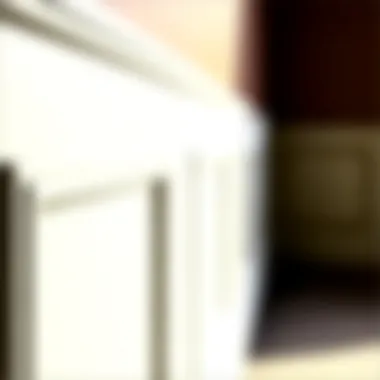
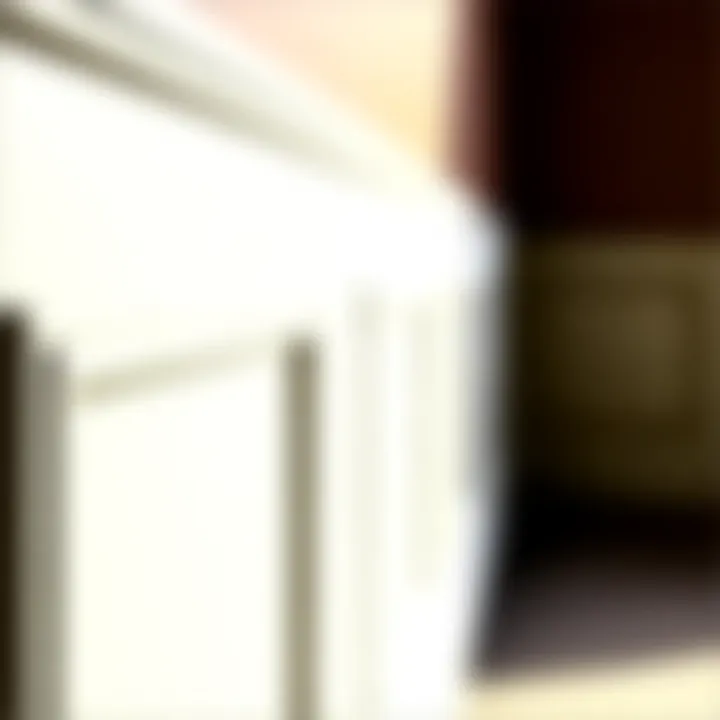
Materials Used in Bathroom Wainscoting
Incorporating wainscoting in bathrooms involves a careful selection of materials to ensure durability and suitability for the humid environment. The choice of material plays a crucial role in not only the aesthetic appeal but also the longevity and performance of wainscoting. Various factors include moisture resistance, ease of maintenance, and overall style compatibility with the existing decor. Understanding these elements helps homeowners and designers choose the best materials that meet their specific needs.
Wood vs. Composite Materials
When deciding between wood and composite materials for wainscoting, the differences are significant. Wood offers a natural warmth and classic beauty. Popular choices like oak, pine, and maple add character but require proper sealing to withstand moisture. However, wood can be susceptible to warping and rot if not adequately treated.
On the other hand, composite materials have gained popularity for their moisture resistance and ease of installation. Products like Medium Density Fiberboard (MDF) or polymer-based options are often lighter and easier to work with than solid wood. They can resemble real wood but are typically less expensive and more consistent in quality.
Choosing between these options involves balancing visual preference, budget, and the specific environmental challenges of a bathroom.
Water-Resistant Options
In bathrooms, water resistance is essential. Here are prominent materials to consider:
PVC
PVC (Polyvinyl Chloride) is highly regarded for its impermeability to moisture. This material does not warp, swell, or rot, making it ideal for bathrooms. Its key characteristic is durability, ensuring a long lifespan even in humid conditions. Advantages include low maintenance and easy cleaning, while disadvantages could include less warmth compared to wood.
Marine Grade Plywood
Marine grade plywood is designed specifically for environments susceptible to moisture. Its key characteristic is the strong adhesive used in construction, allowing it to resist water better than regular plywood. This makes it a popular choice for wainscoting in bathrooms seeking both strength and aesthetics. While it provides excellent durability, it can also be more expensive, which may not suit every budget.
Veneered MDF
Veneered MDF combines the smooth surface of MDF with a wood veneer finish, providing the appearance of natural wood without the downsides. Its main advantage is its resistance to warping and ease of installation. However, it may not be as robust as solid wood in extremely humid conditions, necessitating careful handling when wet.
Finishes and Coatings
The finish and coating applied to wainscoting are essential for enhancing both its appearance and durability. Options range from paint to stains, each serving different purposes.
- Paint can create a clean look, providing a uniform finish that is easy to customize. Choosing a high-quality, moisture-resistant paint helps in protecting the wood beneath.
- Stains help to highlight the natural beauty of wood, adding depth while also offering protection, especially when sealed properly.
- Clear coatings, such as polyurethane, add a protective layer that resists moisture and wear, ensuring the wainscoting withstands the rigors of bathroom usage.
By considering both materials and finishes, homeowners can effectively apply wainscoting in bathrooms, achieving a perfect blend of beauty and functionality.
Design Styles Integrating Wainscoting
The integration of wainscoting into bathroom design is a strategic choice that enhances both functionality and aesthetic appeal. Wainscoting can not only provide physical protection for walls from moisture and wear but also serve as a key design feature that embodies various stylistic choices. Understanding these design styles enables homeowners and designers to achieve a desired atmosphere in the bathroom, aligning the space with personal tastes and existing decor. Choosing the right style requires careful consideration of the overall theme of one’s home, as it creates a balance between the bathroom and adjoining areas. Each design style lends itself to unique elements, benefits, and considerations that can dramatically impact both the look and feel of a bathroom.
Traditional Style
Traditional wainscoting tends to evoke a sense of nostalgia and craftsmanship. It features more ornate designs and classic materials like solid wood. In a bathroom, this style can include raised panel or flat panel options that emphasize symmetry and proportion. Painting this wainscoting in soft pastels or classic whites can highlight its traditional charm while also keeping the bathroom feeling fresh and clean. When integrated correctly, traditional wainscoting can create a sophisticated ambiance, making even smaller bathrooms feel more refined.
- Benefits:
- Timeless appeal
- Enhances elegance in design
Traditional wainscoting, however, demands careful attention to detail during installation to ensure the seamless transition between the wainscoting and bathroom fixtures. The choice of fittings and accessories should harmonize with this aesthetic.
Contemporary Style
Contemporary wainscoting takes a more minimalist approach. It often utilizes sleek lines and modern materials, like composite boards or vinyl. This style tends to focus on clean visuals without excessive ornamentation. In bathrooms, contemporary wainscoting can help achieve a streamlined look, especially when paired with modern fixtures like angular faucets or floating vanities. Typically, this style embraces neutral colors or even bold contrasts, keeping the atmosphere refreshing and relaxed.
- Considerations:
- Emphasis on clean lines
- Material choices complement modern fixtures
Overall, contemporary wainscoting elevates a bathroom’s design while ensuring it remains functional and easy to maintain.
Farmhouse Aesthetic
The farmhouse aesthetic evokes warmth and simplicity. Wainscoting in this style often includes beadboard or board and batten designs, giving the room a rustic charm. The application of natural or distressed finishes enhances this style's authenticity. For bathrooms, this can create a cozy environment, especially when combining wainscoting with vintage decorations and soft textiles. Using muted colors such as soft blues, greens, or creamy whites can deepen the inviting feel of the room.
- Benefits:
- Creates a relaxing, homely vibe
- Easy to mix with vintage or modern decor
Farmhouse wainscoting works to emphasize the serene, comfortable areas of the home, making it a perfect option for those wanting a relaxed, yet stylish, bathroom setting.
Coastal Themes
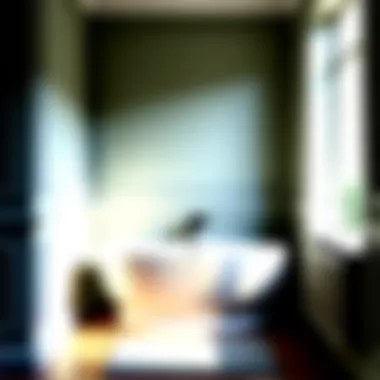
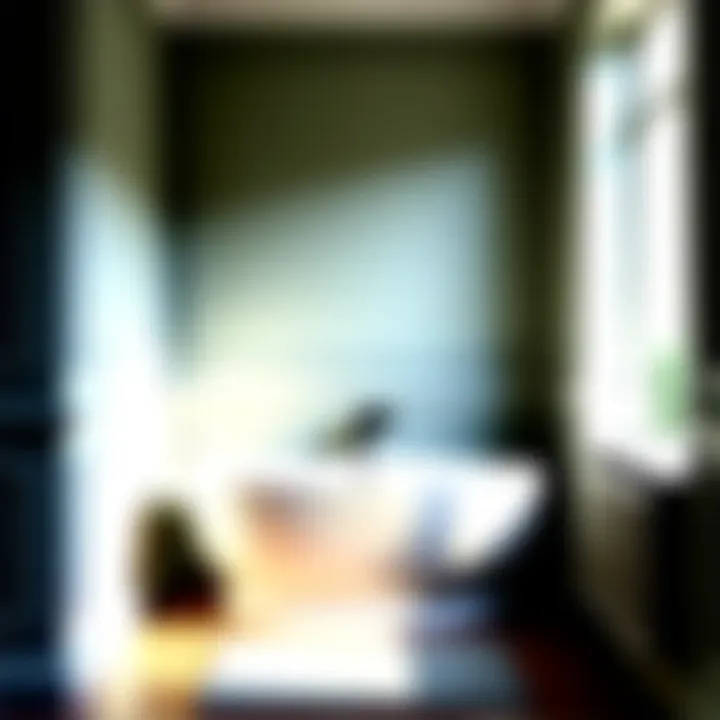
Coastal-themed bathrooms benefit from wainscoting through the use of bright, airy designs. Here, wainscoting can be painted in light hues or sea-inspired colors such as aqua or sandy beige, reflecting the beauty of nature. Beadboard is often the material of choice, creating a nautical feel that’s both fresh and inviting. This style allows homeowners to evoke a sense of tranquility reminiscent of the ocean.
- Considerations:
- Bright colors create a light atmosphere
- Combination with natural textures like wicker or jute
Coastal wainscoting pairs well with large mirrors and windows, maximizing natural light and making the space feel larger and brighter.
Incorporating the right style of wainscoting enhances the visual composition of the bathroom, ultimately impacting its ambiance and functionality.
Installation Considerations for Wainscoting
Wainscoting adds elegance and a certain character to a bathroom. However, it is crucial to consider several factors before beginning the installation process. Understanding the specific requirements of the space and the potential challenges can significantly impact the final look and functionality of the wainscoting. The benefits of a well-installed wainscoting can elevate the aesthetic appeal and offer long-term durability against moisture, a common issue in bathrooms.
Tools Required
Before proceeding with the installation, ensure you have the right tools. Here are the essential tools needed:
- Measuring tape: Accurate measurements are critical to prevent errors.
- Level: Ensures the panels are installed straight.
- Miter saw: Ideal for cutting at an angle when needed for corners.
- Nail gun or hammer: For securing the wainscoting.
- Stud finder: Helps locate wall studs for secure mounting.
- Caulking gun: For applying caulk along seams and joints for a professional finish.
These tools are foundational for achieving a successful wainscoting installation. Having them on hand can save both time and the frustration of making multiple trips to the store.
Step-by-Step Installation Process
Installing wainscoting is not a straightforward task but can be manageable with a clear process.
- Preparing the Wall: Start by cleaning the wall and removing any old fixtures or wallpaper. It's beneficial to patch any holes in the drywall before continuing.
- Measuring and Marking: Measure the height at which the wainscoting will be installed. Mark this on the wall using a level to ensure a straight line.
- Cutting the Panels: Cut the wainscoting panels to size according to your measurements. Always double-check your cuts.
- Mounting the Panels: Use the stud finder to locate the studs and begin attaching the panels with a nail gun or hammer. Ensure each panel is level before securing it completely.
- Adding Trim: Once the panels are securely attached, add any decorative trim, such as a top rail or baseboard, to enhance the overall look.
- Finishing Touches: Apply caulk along the seams and joints to fill gaps and create a clean transition between the wainscoting and wall.
These detailed steps take you from preparation to completion. Each phase is vital to ensure a well-finished product.
Hiring a Professional vs. DIY
One of the many considerations when planning your installation is whether to hire a professional or attempt a DIY project.
- DIY Pros: Cost savings and a personal touch can be rewarding. It can also be a fulfilling project for those who enjoy home improvement tasks.
- DIY Cons: If you lack experience, there is a risk of errors, which can lead to additional expenses for corrections.
- Professional Pros: Expertise ensures a high-quality finish, and professionals have access to better tools and materials.
- Professional Cons: Higher costs may deter some homeowners.
Ultimately, the choice depends on your comfort level with tools and experience. If you lean towards DIY, ensure you thoroughly research the process and prepare adequately to mitigate potential pitfalls.
Maintenance of Wainscoting in Bathrooms
Maintaining wainscoting in bathrooms is crucial to ensure both its durability and the overall aesthetic of the space. A bathroom is a high-humidity environment, which can lead to wear and tear on materials if not properly cared for. Regular maintenance not only prolongs the life of the wainscoting but also helps to preserve its appearance, keeping it looking fresh and appealing. Homeowners should be mindful of the cleaning methods, periodic tasks, and moisture management practices to avoid issues like mold or damage to the wood.
Cleaning Recommendations
Maintaining clean wainscoting is essential for both hygiene and aesthetics. The recommended cleaning methods will vary based on the material used in the wainscoting. For wooden wainscoting, a gentle cleaner mixed with warm water can be effective. Using a soft cloth or a sponge, wipe down the surface to remove any accumulated grime.
For water-resistant materials such as PVC or vinyl, a simple wipe with a damp cloth and a mild detergent is often sufficient. Avoid using harsh chemicals that can damage the finish or surface of the material. In areas prone to splashes or water, consider using a cleaner specially formulated for the bathroom.
Periodic Maintenance Tasks
Routine maintenance is necessary to keep wainscoting in prime condition. Here are a few key tasks:
- Inspect for Damage: Regularly check for any cracks or chips in the material. Early detection can prevent more significant problems down the line.
- Touch-Up Painting or Staining: If the wainscoting is painted or stained, it may require occasional touch-ups to cover scratches or fading.
- Re-Sealing: For wood wainscoting, resealing may be necessary every few years to protect against moisture. Use a suitable water-repellent sealant that will work well in a humid bathroom environment.
These tasks should be incorporated into a seasonal cleaning schedule, ensuring that your wainscoting remains in excellent condition throughout the year.
Dealing with Moisture Issues
Moisture poses a significant risk to wainscoting in bathrooms. To manage this effectively, consider the following strategies:
- Ventilation: Ensure your bathroom is well-ventilated. Use exhaust fans to reduce humidity levels, especially after showers or baths.
- Dehumidifiers: In areas with persistent moisture issues, a dehumidifier can help maintain optimal humidity levels.
- Damage Control: If you notice any signs of mold or mildew, address it immediately. Remove the affected areas and treat them with a mold-resistant solution.
"Regular maintenance not only prolongs the life of the wainscoting but also helps to preserve its appearance."
By prioritizing these maintenance practices, homeowners can protect their investment in wainscoting while enhancing the charm and value of their bathrooms.
Impact on Bathroom Aesthetics
Incorporating wainscoting in bathrooms significantly enhances the space's aesthetics. It offers profound visual impact while adding layers of style and sophistication. The use of wainscoting transforms a standard bathroom into a space of character and warmth. By modifying the wall surface, homeowners can refresh the ambiance of an often-utilized area, making it more inviting.
Visual Appeal
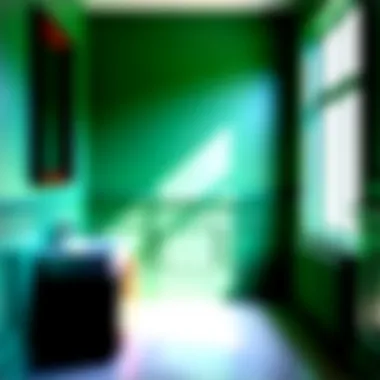
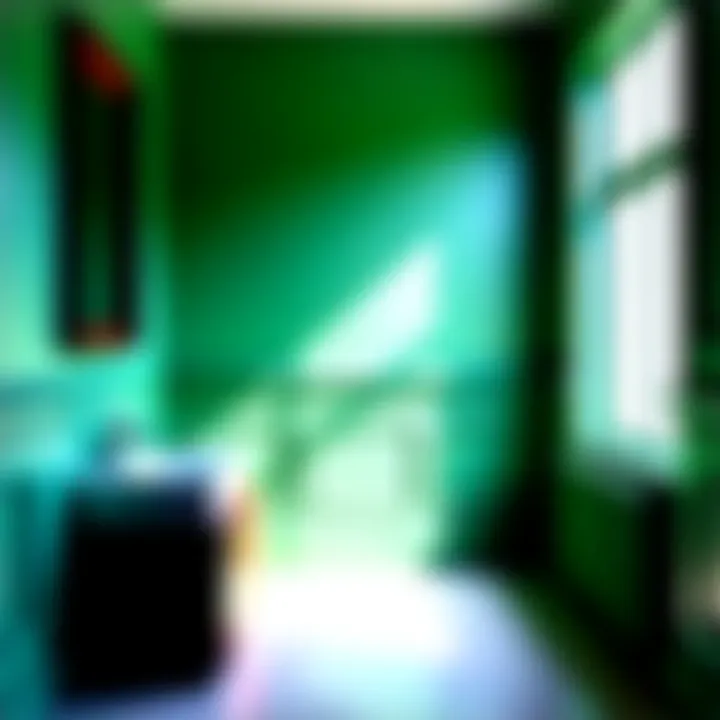
Wainscoting comes in various styles and materials, each contributing uniquely to visual dynamics. Whether opting for a sleek modern look or a more traditional feel, wainscoting serves as a versatile tool in design.
For example, beadboard wainscoting adds texture and creates a cozy atmosphere. Conversely, flat panels might be used for a more streamlined and contemporary edge. With wainscoting, bathrooms can seamlessly blend functionality and visual appeal, speaking to a contemporary design that remains classic.
Homeowners should consider how the choice of material and style aligns with existing design elements. This decision greatly influences not just individual aesthetic preferences but also the overall vibe of the bathroom.
Creating a Cohesive Look
Achieving a cohesive look is essential in bathroom design. Wainscoting can link various design elements across the space, creating a harmonious flow. This style can tie together fixtures, cabinetry, and flooring, removing any fragmentation that might disrupt the eye.
Select a wainscoting style that resonates with your bathroom's current theme. If you have a vintage sink or modern lighting, use wainscoting to complement these aspects rather than contrast them. By maintaining continuity, the bathroom emerges as a pleasing space, both visually and functionally.
It's also possible to utilize wainscoting to demarcate zones within the bathroom. For larger spaces, this can help define areas, such as a shower niche or a freestanding bathtub, guiding the viewer’s attention more effectively.
Color Schemes and Patterns
Color schemes and patterns play a significant role in bathroom design. Wainscoting materials can be painted to fit various palettes, enriching the overall color story of the bathroom. A light palette can make a small space feel larger, while darker hues may create a more intimate setting.
Choosing the right colors should also factor in the existing elements. If the tiles are earthy tones, consider colors that enhance and harmonize with that theme. Patterns in wainscoting can also provide visual interest. Vertical panels can create a sense of height, while horizontal patterns can visually stretch the space.
It's also crucial to consider how these colors and patterns influence lighting. Glossy finishes can reflect light, making the space feel lively, while matte finishes give a more subdued atmosphere, enhancing relaxation.
By thoughtfully selecting colors and patterns for wainscoting, homeowners can significantly impact their bathroom's overall aesthetic, making it a space they cherish.
Cost Considerations
Understanding the cost considerations is crucial for homeowners looking to incorporate wainscoting in their bathrooms. This element goes beyond mere aesthetics; it touches on budgeting, potential return on investment, and the overall financial implications of such a design choice. A thorough analysis of costs can ensure that the project does not go over budget and meets both functional and design expectations.
Budgeting for Materials
When planning for materials, it is essential to evaluate various options. Prices can vary based on the type of wainscoting chosen, such as beadboard, raised panels, or flat panels. Here are some common materials along with their budget implications:
- Vinyl: Among the more affordable choices, vinyl is a cost-effective solution known for its durability and moisture resistance.
- Plywood: Marine grade plywood can be slightly more expensive; however, it offers excellent durability in humid environments.
- Solid Wood: This is often the most expensive option. While it provides a high-quality finish, it may not always be ideal for bathroom conditions if not properly treated.
Before decisions are made, consider obtaining multiple quotes. This allows homeowners to compare prices and choose the best fit for their budget and aesthetic needs.
Labor Costs for Installation
The next element in cost considerations focuses on labor. Installing wainscoting can either be a DIY project or require professional help. For those unwilling to undertake the task themselves, hiring contractors is the standard route. Labor costs can range widely based on location and the complexity of the design. Here are some factors to consider:
- Experience Level: More experienced professionals may charge more but can ensure a better finish.
- Time Required: Complexity and size of the bathroom can influence the time taken for installation.
- Additional Services: Some contractors offer a full package including painting or finishing, which can impact overall pricing.
Assessing all these variables is pivotal for homeowners looking to optimize their investment in the remodeling process.
Long-Term Investment Value
Investing in wainscoting can provide significant long-term value. A well-executed installation can enhance the bathroom's aesthetic appeal, potentially increasing the home’s market value.
Consider these points:
- Aesthetic Longevity: Wainscoting is a timeless design feature, often remaining in style regardless of changing trends.
- Durability: High-quality materials that resist moisture can decrease long-term repair costs, making the initial investment worthwhile.
- Enhanced Marketability: A beautifully finished bathroom with wainscoting can attract buyers, enhancing the property's sale potential.
Wainscoting and Sustainability
Sustainability in home design is becoming increasingly essential as homeowners seek to minimize their ecological footprints. Wainscoting, traditionally seen as a purely aesthetic choice, can contribute positively to sustainability efforts when planned and executed thoughtfully. The application of sustainable practices in wainscoting helps homeowners make informed choices that benefit not only their interiors but also the environment.
One of the most significant aspects of wainscoting and sustainability is the choice of materials. The use of sustainable materials not only reduces the carbon footprint but also enhances the quality of the home environment. When exploring options for wainscoting in bathrooms, it is crucial to consider the source and characteristics of the materials.
For instance, materials that are sourced from sustainably managed forests or those that are reclaimed can significantly lower environmental impact. By prioritizing materials that are certified as sustainable, homeowners can support responsible forestry and reduce waste.
Additionally, sustainability in wainscoting involves long-term use and maintenance considerations. Choosing high-quality materials can extend the life of the wainscoting, reducing the need for replacements and minimizing waste.
"Selecting sustainable materials and practices in wainscoting reflects a commitment to preserving our environment while enhancing the beauty of our homes."
Sustainable Materials
When selecting materials for bathroom wainscoting, several sustainable options are available. Opting for materials like bamboo, recycled wood, and certified hardwood not only contributes to aesthetic value but also supports sustainability.
- Bamboo: Rapidly renewable, bamboo is an excellent choice due to its growth rate and strength. It can be treated for moisture resistance, making it suitable for bathroom environments.
- Recycled Wood: This option helps reduce deforestation and is often a unique selection that adds character to the space.
- Certified Hardwood: Look for materials that are certified by organizations like the Forest Stewardship Council (FSC), which ensures responsible sourcing.
- Reclaimed Materials: Using reclaimed wood or panels reduces waste and encourages recycling efforts while providing a rustic charm.
Recycling Options and Practices
Recycling plays a pivotal role in the sustainability of wainscoting applications. Homeowners can explore various recycling options to promote an environmentally responsible approach to home renovation. It is essential to consider how materials can be reused or disposed of responsibly.
- Reusability: Many wainscoting materials can be reused in other areas of the home or refurbished for a new look. Consider reusing existing wood from renovations or upgrades.
- Local Recycling Programs: Check with local waste management services to find out if they accept construction materials for recycling.
- Donate or Sell: If the wainscoting is in good condition, consider donating to local charities or selling through platforms like Facebook Marketplace.
- Upcycling: Turn scrap materials into decorative items or functional pieces for the home, reducing waste while staying creative.
Incorporating sustainability into wainscoting not only improves the functionality of a bathroom but also aligns it with a more eco-conscious lifestyle. By thoughtfully selecting materials and considering recycling options, homeowners can create a beautiful bathroom environment without compromising on environmental responsibility.


